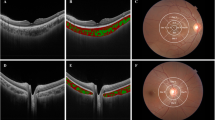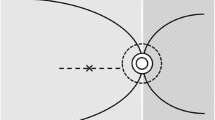Abstract
Diffuse choroidal atrophy first appears around the optic disc. In a recent longitudinal study, among 35 eyes of adult patients with signs of myopic maculopathy, 83% showed a peripapillary diffuse choroidal atrophy (PDCA) already in childhood. This study suggested that the presence of PDCA in children with high axial myopia might be an indicator of eventual pathologic myopia in adulthood. According to the study using swept-source OCT on children with PDCA, the segmental and abrupt thinning of the choroid in the temporal parapapillary region is characteristic to PDCA. The study also showed that a choroidal thickness measurement with cut-off value of <60 μm at 2500 μm nasal to the fovea can be used to detect children with PDCA with a 75.6% sensitivity and 100% specificity.
Access provided by Autonomous University of Puebla. Download chapter PDF
Similar content being viewed by others
Keywords
1 Peripapillary Diffuse Choroidal Atrophy (Category 2)
Generally, the area of diffuse choroidal atrophy first appears around the optic disc, as peripapillary diffuse chorioretinal atrophy (PDCA). In a recent longitudinal study [1], 35 eyes of 19 adult patients with signs of severe myopic maculopathy (mean age; 37.0 ± 5.1 years (range, 33-42 years) and mean axial length; 27.8 ± 1.2 mm (range, 25.5-29.7 mm)) were retrospectively analyzed. The results showed that 29 of the 35 eyes (83%) showed a PDCA at the initial visit (age 10.5 ± 2.6 years; range, 5-15 years. In those cases, PDCA was confined to the area temporal to the optic nerve head outside of the parapapillary alpha, beta, gamma, or delta zones (Figs. 8.1 and 8.2). This study suggested that the presence of PDCA in children with high axial myopia might be an important biomarker for eventual pathologic myopia in adulthood.
The following study investigating morphologic features of PDCA in children using swept-source OCT [2] revealed a profound segmental and abrupt thinning of the choroid in the temporal parapapillary region. The parapapillary segmental thinning of the choroid with an abrupt border in direction to the slightly thicker macular choroid was an OCT feature of PDCA (Figs. 8.3 and 8.4). Using a choroidal thickness cut-off value of <60 μm at 2500 μm nasal to the central fovea, 31 of the 41 eyes (76%) with PDCA and none of the eyes in the control group comprised of participants of the population-based Gobi Desert Children Eye Study (0/1463)-except for one child with PDCA-were positive for this sign. The study proposed a potentially useful cut-off value of choroidal thickness at a distance of 2500 μm nasal to the foveola may be the value of <60 μm, which may be helpful for the detection and diagnosis of PDCA in myopic children.
Peripapillary diffuse choroidal atrophy (PDCA) seen in children who eventually develop severe myopic atrophy in adulthood (Reproduced with permission from [1]). (Left) Right fundus of a 12-year-old boy with a refractive error of -13.0 diopters (D) and axial length is 28.4 mm shows PDCA temporal to the optic disc. (Right) When the patient is 41-years old, diffuse atrophy has enlarged beyond the macular area (especially in the inferior fundus) and has become macular diffuse choroidal atrophy (MDCA). Refractive error has increased to -20.0 D and axial length has increased to 30.6 mm
Peripapillary diffuse choroidal atrophy (PDCA) seen in children who eventually develop severe myopic atrophy in adulthood (Reproduced with permission from [1]). (Left) Right fundus of a 11-year-old girl with a refractive error of -18.0 diopters (D) and an axial length of 27.2 mm shows PDCA temporal to the optic disc. (Right) When the patient is 41 years-old, diffuse atrophy has enlarged to cover the entire posterior fundus. Patchy atrophy is also seen temporal to the macula. Refractive error has increased to -20.5 D and an axial length has increased to 32.3 mm
Extreme and sudden thinning of the peripapillary choroid in a child with peripapillary diffuse choroidal atrophy (PDCA) (Reproduced with permission from [2]). (Top) Right fundus of an 11-year-old girl with refractive error of -11.0 D (spherical equivalent) and with axial length of 27.8 mm shows yellowish PDCA temporal to the gamma zone. (Bottom) A horizontal section of OCT shows extreme thinning of the choroid temporal to the optic nerve. Almost the entire thickness of the choroid has disappeared in the area of PDCA nasal to the central fovea, although the choroid seems to maintain its thickness temporal to the fovea. The transition from relatively normal choroid around the fovea to almost absent choroid in the area of PDCA is sudden
Extreme and sudden thinning of the peripapillary choroid in a child with peripapillary diffuse choroidal atrophy (PDCA) (Reproduced with permission from [2]). (Top) Right fundus of a 9-year-old girl with refractive error of -10.25 D (spherical equivalent) and with an axial length of 26.4 mm shows yellowish PDCA temporal to the gamma zone. (Bottom) A horizontal section of OCT shows extreme thinning of the choroid in the area of PDCA. Almost the entire thickness of the choroid has disappeared in the area of PDCA nasal to the central fovea, although the subfoveal choroid seems to maintain its thickness. The transition from relatively normal choroid around the fovea to almost absent choroid in the area of PDCA is relatively sudden
References
Yokoi T, Jonas JB, Shimada N, Nagaoka N, Moriyama M, Yoshida T. Peripapillary diffuse Chorioretinal atrophy in children as a sign of eventual pathologic myopia in adults. Ophthalmology. 2016;123:1783–7.
Yokoi T, Zhu D, Bi HS, Jonas JB, Jonas RA, Nagaoka N. Parapapillary Diffuse Choroidal Atrophy in Children Is Associated With Extreme Thinning of Parapapillary Choroid. IOVS. 2017;58(2):901–6.
Author information
Authors and Affiliations
Editor information
Editors and Affiliations
Rights and permissions
Copyright information
© 2020 Springer Nature Singapore Pte Ltd.
About this chapter
Cite this chapter
Igarashi-Yokoi, T. (2020). Peripapillary Diffuse Atrophy (PDCA). In: Ohno-Matsui, K. (eds) Atlas of Pathologic Myopia. Springer, Singapore. https://doi.org/10.1007/978-981-15-4261-9_8
Download citation
DOI: https://doi.org/10.1007/978-981-15-4261-9_8
Published:
Publisher Name: Springer, Singapore
Print ISBN: 978-981-15-4260-2
Online ISBN: 978-981-15-4261-9
eBook Packages: MedicineMedicine (R0)








